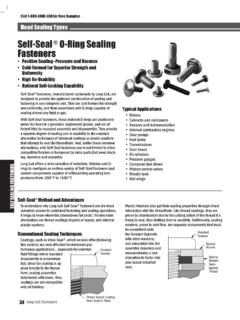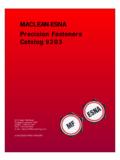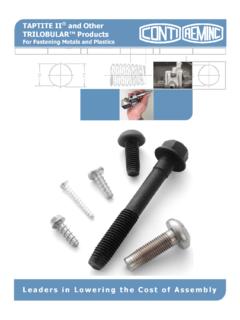Transcription of Self-Locking & Self-Sealing Fasteners Handbook - Long-Lok
1 Long-Lok Fasteners CorporationCustom Solutions to Special Problems in fastener EngineeringSelf- locking & Self-Sealing Fasteners HandbookAS 9100 Certified ISO 9001:2008 CertifiedLong-Lok Fasteners Missiles to Laundry Equipment to Precision Instruments to Heavy MachineryThank you for looking to Long-Lok ! We ve been solving fastener problems for engineers and buyers for more than 40 years. And you ll find we re ready today to fill any requirement you have for Self-Locking and Self-Sealing Fasteners or threaded components. Today, Long-Lok Fasteners are found around the world and even above it. We re securing and sealing the appliances in our homes, the cars and trains that get us to work, the satellites that allow us to communicate, and the vehicles that mine the Earth and explore her ocean s depths.
2 Now we want to be on your project! This Handbook provides you with a good overview of our products. In most cases you will be able to order with the information contained on the following pages. But keep in mind our ability to develop custom fastening products and to work directly with your specialty components. So, if you don t see it us; most likely we can make it!You ll find at Long-Lok a group of individuals dedicated to seeing your project succeed. You won t find another fastener company with the capability, the array of locking and sealing methods offered, or the determination to be the standard of excellence for locking and sealing Fasteners . So, contact us today and leave it to Long-Lok ! Long-Lok Fasteners Corp. 1993-2006 Long-Lok Fasteners Corporation.
3 All rights subject to change without following tradenames are used in this catalog. They belong to their respective owners: Poly-Lok, Long-Lok , self -Seal, Dyna-Thred, Tek-Lok, Hot-Lok, Dual-Lok, Omni-Lok Long-Lok Fasteners Corp.; Loctite, Dri-Loc, Vibra-Seal Loctite Corp.; Viton, Teflon, Kalrez, Vespel DuPont Co.; Kel-F 3M Co.; Inconel, Monel, K-Monel Inco Alloys Internat.; StalGard Elco Ind.; SermaGard Sermatech Internat.; 17-4PH Armco Materials Chester Road, Cincinnati, OH 45215 513/772-1880 Fax: 513/772-188820501 Belshaw Avenue Carson, CA 90746-3505 424/213-4570 Fax: 424/213-4584 Contents PageIntroduction to Self-Locking Fasteners What They Are and How They Work 3 - 4 Basic Types of Self-Locking Fasteners 4 - 5 Application Problems.
4 Solutions & Considerations 6 - 8 Installation Data 8 Glossary of Terms 9 torque Calculations 10-11 Guide to MS and NAS Self-Locking Fasteners 12 Manufacturing Specifications and Standards 13 Selection Guide 14 Special Thread locking Applications 15 Self-Locking Fasteners Material Additive Types Poly-Lok Patch 16-17 Long-Lok Strip 18-19 Tek-Lok Pellet 20-21 Dual-Lok 22 Omni-Lok 23 All-Metal Type Dyna-Thred II 24-27 Chemical Additive Type Dri-Loc Pre-Applied Adhesive 28-29 Self-Locking Inserts T-Sert Inserts 30-33 Self-Sealing Fasteners self -Seal O-Ring Type 34-41 Vibra-Seal Pre-Applied Coating Type 42-43 Part Number Selection Poly-Lok, Long-Lok & Tek-Lok Fasteners 46 - Inside Back CoverLong-Lok Fasteners3 Poly-Lok Patch BoltNo locking deviceSplit lockwasherExternal tooth lockwasher500040003000200010001020304050 60708090100110120130140 TIME IN MINUTESPRE-LOAD (LBS.)
5 What They Are and How They WorkThreaded parts have a : Parts which have been joined by threaded fasten-ers can be disassembled and reassembled when they must be serviced or : Threaded Fasteners unintentionally back off when the assembly is in use, and the consequences are usu-ally inconvenient, costly and may present serious legal impli-cations for product torque Type Threaded fastener frictionally resis-tant to rotation due to a built-in wedge. This type of fastener retains its locking ability independent of axial tension or torque Sometimes referred to as Loading torque . Typically measured in inch pounds , a value of torque ap-plied to a fastener to induce a compressive load under the head bearing surface. Results in creating an axial load (pre-load) that imparts tension or a stretching/elongation charac-teristic to a male threaded torque The torque necessary to start relative ro-tation between a locking fastener and its mating thread with no axial load on the screw.
6 This will change with reuse and be referred to as the 1st Off , 5th Off torque and so forth. This is the torque due to the locking element torque The amount of torque required to start disassembly of an axially loaded fastener . The torque due to clamp load torque The highest reading indicated by a torque measuring device while the screw or nut is being fully engaged but prior to any axial loadingLocking torque The resistance to rotation. A measure of the performance of the Self-Locking device. Does not include the torque necessary to induce or remove any axial load in the Off torque (a) Maximum. The highest reading indicated by a torque measuring device while the screw or nut is being backed off throughout the first 360 degrees of rotation after the axial load is reduced to zero after breakaway.
7 (b) Minimum. The lowest reading indicated by a torque measuring device while the screw or nut is being backed off throughout the first 360 degrees of rotation after the axial load is reduced to zero after breakaway. (NOTE: The use of a memory device on the torque wrench makes it easy to record the maximum prevail-ing torque , but the indicator must be watched carefully in order to record the minimum prevailing torque .)An additional Glossary of terms is found on Page they workThe Self-Locking fastener was developed to retain the advan-tage of reusability while preventing the problems of acciden-tal disassembly when pre-load is lost. Self-Locking Fasteners virtually eliminate the possibility of a bolted assembly coming apart during operation.
8 To achieve this benefit, the self -lock-ing fastener has to to be properly designed, engineered and pre-load is lost, as shown in the chart below, a standard fastener quickly vibrates out, causing the assembly to loosen. The Self-Locking fastener s primary function is to prevent backing off when the initial axial tension is to vibrate out after pre-load INTRODUCTIONI ntroduction to Self-Locking Fasteners Long-Lok Fasteners4By doing so, Self-Locking helps maintain a tight joint and also helps prevent fatigue failure in the joint. Self-Locking fasten-ers resist rotation on the first installation and on subsequent installations and removals. In addition, Self-Locking Fasteners also decrease the tendency of the fastener to fatigue by re-ducing the vibration transferred to the Common AlternativesJam nuts, cotter pins, lock nuts, lock washers and similar devices also prevent the loss of the bolt or nut by back off but they result in added weight, inconvenience and cost.
9 They do not reduce the tendency to fatigue when , the insecurity of conventional mechanical locks are reason enough for most designers to reject them. Such insecurity arises from the frequency of split-type washers breaking, damage to surface areas caused by external locking devices, and the ineffectiveness of such devices when adjust-ments are They Are and How They Work continuedThis type involves two alternative methods of application, pre-applied and applied-in-place. These Fasteners have a lower assembly torque than that achievable from prevailing torque type Fasteners . Additionally, high breakaway torques are achieved due to the solid fill from the adhesive coating after full pre-applied and applied-in-place chemical adhesives offer the locking reliability characteristics of most other Self-Locking fastener chemical application, however, of chemical addi-tives offer just one-time use and additional assembly time is required to coat the fastener with the additive.
10 Downtime, application errors and contamination of other assembly parts are all inherent risks with in-place application of chemical additive chemical additive Fasteners are manufactured with the adhesive coating pre-applied via a sophisticated mi-cro-encapsulation process. The adhesives are usually an an-aerobic type, or a two part epoxy, with the material positioned in a band around the threads and dry to the touch. When the fastener is rotated against its mating part the capsules of ad-hesive burst, releasing the material in and around the thread flanks, which then cures and forms the locking the adhesive coating is pre-applied, the assembly time for these Fasteners is substantially less than for applied-in-place coatings.





